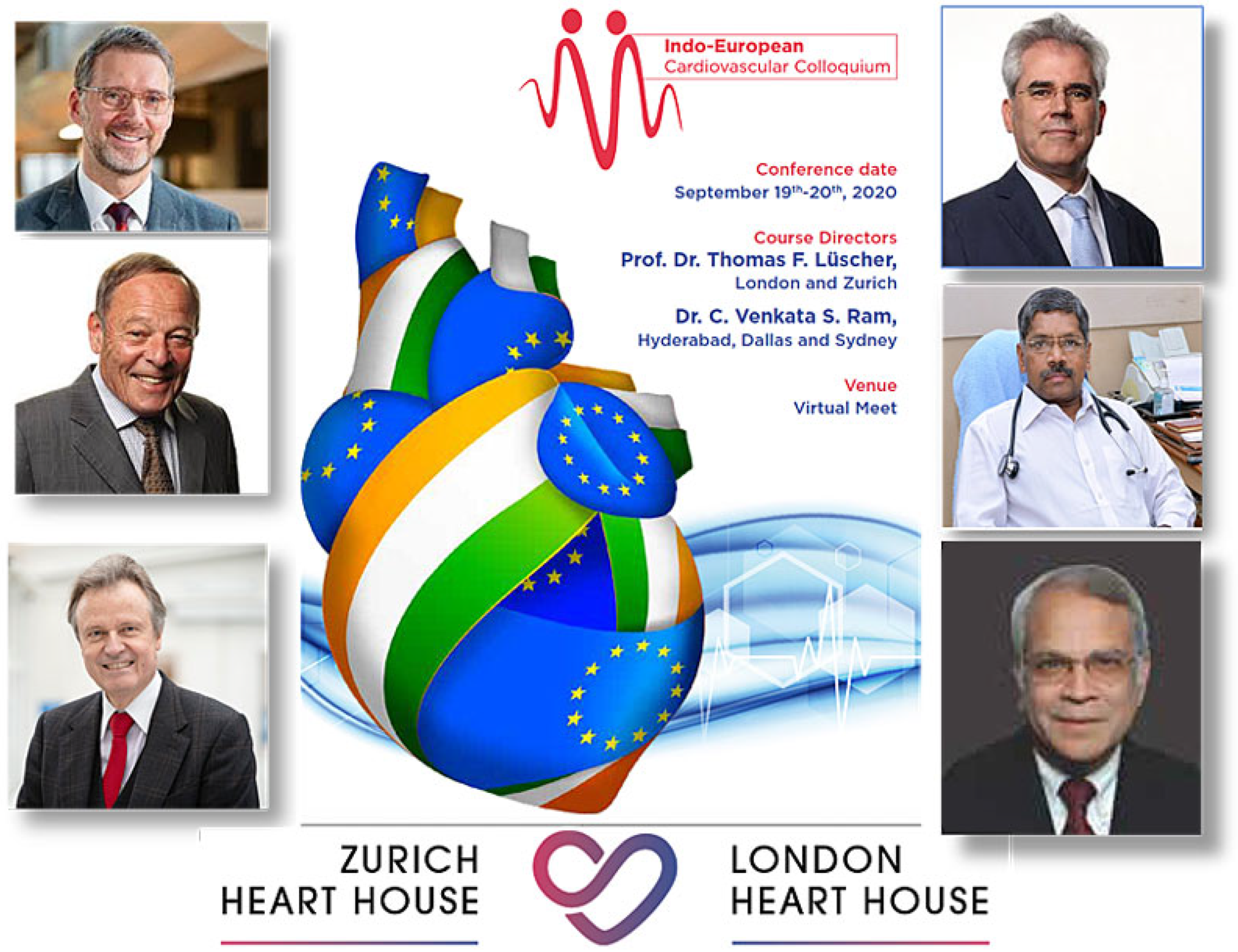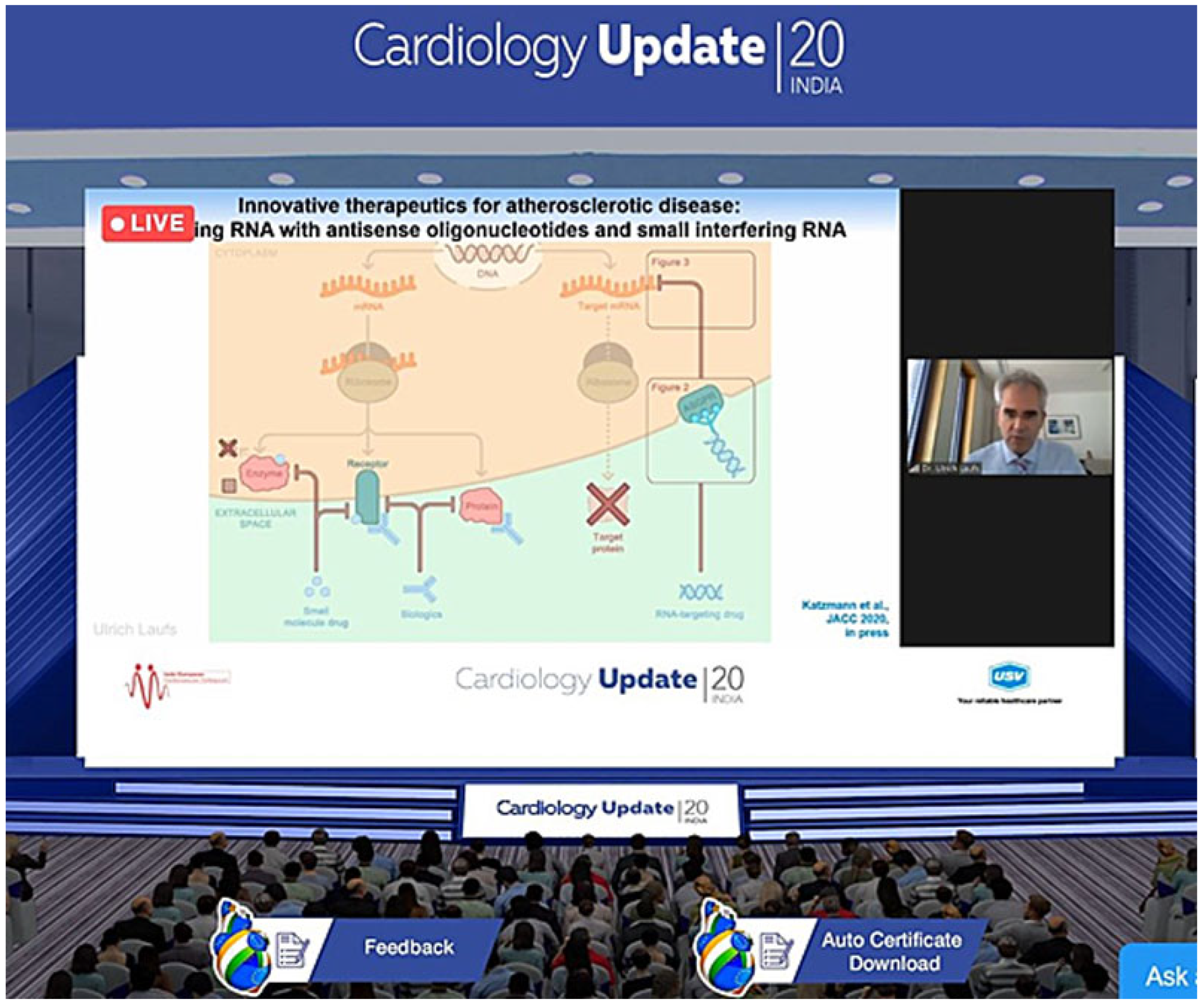During the COVID-19 pandemic postgraduate education is quite challenging, as face-to-face meetings are prohibited, particularly where infection rates are high. This is especially the case for India, where in 2019 a first Cardiology Update was held in Mumbai with over 700 participants. In the context of the current COVID-19 pandemic, a face-toface postgraduate course was unthinkable. Indeed, many important faculty members are unable to travel because of restrictions imposed by their institution and/or country, particularly those from the United States and the United Kingdom. As a consequence, the organiser, the Zurich and London Heart House decided to run the Cardiology Update 20 India as a fully online event, with shorter than usual talks over two afternoons on 19 and 20 September 2020. To provide an interactive atmosphere, prolonged panel discussions of 30 minutes or more were part of each session.
The course was run by excellent chairpersons from India, the USA, the UK and Europe (
Figure 1) and shortened to account for the online format. There were four sessions on two afternoons, Saturday and Sunday19 and 20 September This strategy paid off, as reflected by an impressive number of participants – 7000 colleagues from across India.
Session 1: Prevention was chaired by Ulrich Laufs from Leipzig University, Germany, and P.P. Mohanan from Thrissur, India, with lectures from the Course Director, Thomas F. Lüscher, on “A personalised approach towards prevention”, followed by C. Venkata S. Ram from Hyderabad, India, also Director of the course, on “Hypertension 2020”. Lipids have been a focus of interest recently and, accordingly, a lecture by Ulrich Laufs on “Dyslipidaemia: treatment targets and novel strategies according to the new 2019 ESC guidelines” was most relevant and highly appreciated (
Figure 2). Finally, “Optimal pharmacotherapy to achieve lipid target levels in clinical practice” was reviewed by J.B.S. Sawhney from New Delhi, India. A lively panel discussion with participation of the audience was most stimulating and led to the second session.
Session 2: Coronary artery disease: an overview was chaired by Bernard Gersh from the Mayo Clinic, Rochester, USA together with C.K. Ponde from Mumbai, India. Bernard Gersh outlined the implications of the ISCHEMIA Trial for clinical practice and also for guidelines to come. He explained that the ISCHEMIA Trial really tested a strategy rather than an intervention and showed clearly that percutaneous coronary interventions (PCIs) in patients with chronic coronary syndromes have no impact on outcomes, but improve quality of life and symptoms of angina, particularly in those with more severe impairment of their everyday activities. After PCI, obviously, secondary prevention is important and this was reviewed by Ajit Mullasari from Chennai, India in “Dual antiplatelet therapy: scientific evidence and a practical guide”. This was followed by a nice review on “What is the current status and evidence for aspirin usage in the prevention of vascular disease?” by P.P. Monhanan from Thrissur, India, who reminded us how weak the evidence for efficacy of aspirin in primary prevention is and how large the potential for harm, particularly bleeding. This is of particular concern in the elderly. Nevertheless, it has to be remembered that in patients with an acute ST segment elevation myocardial infarction (STEMI), aspirin has an important effect on short-term mortality.
Session 3: Cardiovascular disease: hot topics involved lectures on arrhythmias, aortic valve disease and non-invasive imaging by eminent speakers. It began with a tutorial on difficult ECGs by Calambur Narasimhan from Hyderabad, India, followed by a splendid lecture on the “Management of aortic valve disease in 2020” by Lars Soendergaard from Copenhagen, Denmark. He informed the participants that transcatheter aortic valve implantation (TAVI) really has become the first choice in patients with calcific aortic stenosis at high or low risk, mainly for those with an age of 70 years or higher. Evidence is still lacking in younger patients, as the durability of TAVI valves is still not well documented. Nevertheless, the impressive success of TAVI procedures is reflected in the currently very low mortality, short hospital stays of a few days and rapid improvement of symptoms. Rishi Sethi from Lucknow, India then reviewed for the participants the various non-invasive modalities used to detect coronary artery disease and critically discussed the pros and cons of all imaging techniques available currently in clinical practice.
Session 4: Cardio metabolic disorders; heart failure was chaired by Calambur Narasimhan and Martin Cowie from the Royal Brompton Hospital, London, UK. The session began with a lecture by Nagaraj Desai from Bangalore, India on the “Importance of additional cardiovascular risk reduction in diabetes: the role of statins”. Ulrich Laufs then reviewed the new treatment modalities for diabetics with heart failure and heart failure patients with diabetes, as well as heart failure patients without diabetes. The sodium glucose transport inhibitors are a real breakthrough in cardiovascular medicine and have offered new opportunities to markedly improve outcomes in this patient population. This has been emphasised by the ESC Guidelines on Diabetes, Prediabetes and Cardiovascular Disease, also outlined by Ulrich Laufs. Then Rajeev Agarwala from Meerut, India spoke on “Adjunctive and complementary therapeutic approaches to decrease the overall cardiovascular disease risk in the community”. Finally, Jamshed Dalal from Mumbai, India spoke on the “Rationale behind combination lipid lowering therapy in high risk patients”.
C. Venkata S. Ram and Thomas F. Lüscher concluded enthusiastically that this year’s online Cardiology Update 20 India was a true success, thanks to splendid lectures and impressive participation of over 7000 colleagues from physicians from all over India and beyond. It further strengthened education across India and Europe and fostered the various new ESC guidelines for the management of cardiovascular patients.





